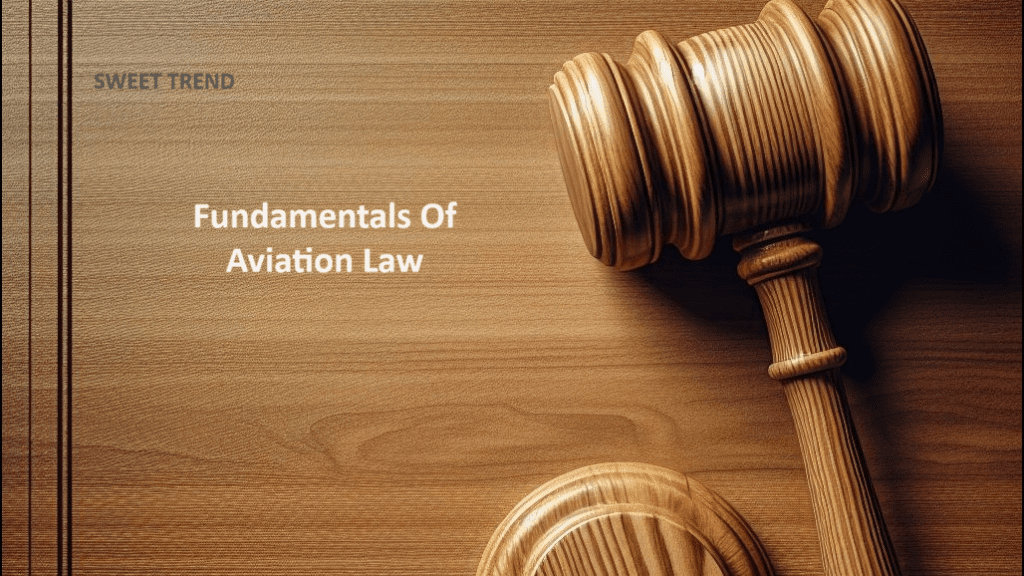Flying has always fascinated humanity, from the mythical stories of Icarus and Daedalus to the revolutionary advancements in modern aviation. However, behind the glamour and thrill of soaring through the skies lies a complex legal framework that governs every aspect of flight. Welcome to the fascinating world of aviation law, where regulations and principles intersect with technology and human ingenuity.
Whether you are a pilot, an aircraft manufacturer, or simply an enthusiast curious about how our skies are regulated, understanding the fundamentals of aviation law is essential for anyone involved in this exhilarating industry. In this article, we will delve into the key concepts and principles that form the bedrock of aviation law, exploring everything from airspace rights to safety regulations. So fasten your seatbelts and get ready for a journey through the legal skies!

Overview of aviation law and its importance
Aviation law serves as the backbone of the aviation industry, providing a regulatory framework that ensures safety, security, and accountability. It encompasses various legal aspects, such as international agreements, national laws, rules and regulations governing air travel operations, and liability issues. The fundamental purpose of aviation law is to safeguard passengers, crew members, and third parties while maintaining operational efficiency.
One key aspect of aviation law is its international nature. Both public and private entities are interconnected globally in the aviation industry; therefore, a comprehensive legal system is necessary to regulate cross-border activities. For instance, international agreements like the Chicago Convention created a foundation for global cooperation among nations concerning airspace sovereignty and establishing basic principles for air travel regulation. These collaborations not only ensure smooth operations but also promote consistency in standards across different jurisdictions.
Additionally, aviation law plays a critical role in addressing liability concerns arising from accidents or incidents within the industry. In such cases, it provides a framework for determining fault and allocating responsibility for damage or injuries sustained by passengers or affected parties on the ground. This promotes accountability among airlines and other relevant stakeholders while offering protection to individuals affected by unfortunate events.
Overall, aviation law stands as an essential pillar of the aviation industry’s sustainability and growth by ensuring uniformity in regulations worldwide. Not only does it provide necessary safeguards for all involved parties but acts as a catalyst for technological advancements and innovation within this dynamic sector.
History: Evolution of aviation regulations (Fundamentals Of Aviation Law)
The evolution of aviation regulations is a fascinating journey that showcases humanity’s gradual adaptation to the ever-changing aviation industry. At its core, these regulations aim to ensure the safety, efficiency, and orderly conduct of air travel. With the advent of powered flight in the early 20th century came a pressing need for rules and guidelines to govern this revolutionary mode of transportation.
Over time, as air traffic grew exponentially, governments around the world recognized the necessity for a harmonized regulatory framework. From ICAO’s Chicago Convention in 1944 to the establishment of national aviation authorities like the FAA in the United States, many milestones have been achieved in shaping modern-day aviation laws. These regulations encompass a wide range of aspects such as airworthiness standards for aircraft design and maintenance, licensing requirements for pilots and crews, and operational rules to ensure smooth air traffic flow.
One key aspect driving continuous evolution is technological advancement. As new aircraft designs emerge or innovative navigation systems are introduced, regulators must adapt swiftly to incorporate these changes into existing frameworks. The rise of commercial drones is an excellent example; their exponential growth has necessitated updated regulations on issues like flight paths and altitude limits.
In conclusion, understanding the history and evolution of aviation regulations allows us not only to appreciate how far we’ve come but also provides critical insights into why certain laws exist today. By keeping pace with evolving technology while prioritizing safety above all else, regulators continue shaping our skies into safer havens for future generations’ airborne adventures.
International Aviation Law: Global standards and treaties
International aviation law plays a crucial role in maintaining global standards and ensuring the safety and efficiency of air travel. It encompasses various treaties, agreements, and regulations that govern everything from aircraft maintenance to airspace management. One fundamental aspect of aviation law is the Chicago Convention, signed in 1944, which established the International Civil Aviation Organization (ICAO) as the governing body for international civil aviation. The ICAO sets forth standards and recommended practices to ensure harmonization among member states. These standards cover areas such as flight operations, air navigation services, aerodromes, environmental protection, and aircraft accident investigation.
Another significant treaty in international aviation law is the Montreal Convention of 1999. This treaty governs liability for international carriage by air and aims to protect passengers’ rights when traveling internationally by establishing uniform rules across different countries. It introduces provisions relating to compensation for flight delays or cancellation, lost luggage or damaged cargo claims. The Montreal Convention also sets strict liability guidelines for accidents resulting in injury or death during flights.
By establishing these global standards and treaties, international aviation law ensures a consistent framework that promotes safe and efficient air travel worldwide while protecting both passengers’ rights and airline operators’ interests. Compliance with these laws not only enhances safety but also facilitates seamless connectivity among nations through a well-regulated global network of airports and airlines.
Overall, understanding the fundamentals of international aviation law provides insight into how nations collaborate to ensure safe skies globally while enhancing traveler experiences by providing legal protections throughout their journeys.
National Aviation Law: Regulation at the country level
National Aviation Law is the backbone of any country’s aviation industry, setting the rules and regulations that govern everything from air safety to aircraft operations. These laws are essential for maintaining order and ensuring the smooth functioning of the aviation sector. While the fundamentals of aviation law are similar across countries, each nation has its own unique set of regulations that reflect its specific needs and context.
For instance, some countries may prioritize certain aspects like noise pollution control due to densely populated urban centers, while others might focus more on environmental sustainability or security measures. Additionally, national governments often collaborate with international bodies such as ICAO (The International Civil Aviation Organization) to ensure harmonization and consistency in global aviation standards.
Understanding these country-level regulations reveals the complexity involved in managing an interconnected network of airspace. The dynamic nature of aviation necessitates constant adaptation to new technologies, emerging threats, and changing global trends. As a result, national aviation laws play a crucial role in providing guidelines for airlines, airports, pilots, air traffic controllers, and other stakeholders within their respective jurisdictions.
Keeping up with these evolving laws ensures compliance with safety protocols and fosters innovation within the industry. Moreover, it promotes international cooperation between nations by facilitating agreements on matters such as landing rights or bilateral alliances – things that help promote tourism and economic growth through air travel.
In summary, while there may be core principles binding all countries when it comes to aviation law at its foundation level; there is no one-size-fits-all approach when it comes down to implementation on a country-by-country basis. National Aviation Law bends accordingly after taking into consideration geographic characteristics peculiar domestic concerns about security/territory/pollution&environmental issues creating sustainable eco-friendly flying destinations ties & closing deals leading towards globalization keeping check-and-balance strategies among states working hand-in-hand with international organizations such as ICAO elevating worth economical boundaries via inter-regional collaborations assuring ease-of-movement & reduced time spent on borders.
Key Components: Safety, security, and environmental regulations
Safety, security, and environmental regulations are the fundamental pillars of aviation law that ensure the integrity of air travel. Safety regulations are designed to protect passengers and crew members from accidents or incidents during flight. These regulations encompass everything from aircraft maintenance standards to pilot training requirements. Airlines must adhere to strict guidelines set by governing bodies such as the International Civil Aviation Organization (ICAO) to guarantee the highest level of safety for all flights.
Security regulations play a crucial role in preserving the well-being of passengers and preventing acts of terrorism or unlawful interference on board an aircraft. Enhanced passenger screenings, baggage checks, and secure cabin procedures are just a few examples of security measures put in place by airlines worldwide. In recent years, we have witnessed a significant shift towards advanced technologies like biometric identification systems and facial recognition at airports as part of efforts to further bolster aviation security.
Environmental regulations have become increasingly important as concerns over climate change continue to grow. Airlines are under increased scrutiny to reduce their carbon footprint through initiatives such as investing in fuel-efficient aircraft models, adopting sustainable aviation fuels, and implementing robust recycling programs. Some countries have even introduced taxes on aviation fuel emissions as they recognize the need for stricter environmental policies within this industry.
The interdependence between safety, security, and environmental regulations creates a holistic approach to ensuring responsible aviation practices worldwide.
Legal Liability: Rights and responsibilities in aviation accidents
When it comes to aviation accidents, understanding legal liability is crucial for all parties involved. Pilots, aircraft manufacturers, maintenance crews, and even air traffic controllers have rights and responsibilities that must be considered in the aftermath of an accident. However, navigating the complexities of aviation law can be challenging.
One fundamental aspect of aviation law is the concept of negligence. In aviation accidents, negligence refers to a failure to exercise reasonable care that causes harm or injury to others. But determining who is at fault can be a complex process. It’s not just about identifying the immediate cause of an accident; it also involves examining any contributing factors such as improper training or maintenance issues that may have led to the incident.
Victims and their families also have rights when it comes to seeking compensation for damages resulting from an aviation accident. They can file lawsuits against multiple parties responsible for their injuries or loss, including pilots, airlines, aircraft manufacturers if defects contributed to the crash, and even government entities if air traffic control played a role in the incident. Understanding these legal rights empowers victims by giving them avenues through which they can seek justice and compensation.
Aviation accidents are devastating events with far-reaching implications for everyone involved. Whether you’re a pilot striving to adhere to safety protocols or a victim seeking justice after an accident, understanding your legal rights and responsibilities is essential in navigating this complex field. By grasping the fundamentals of aviation law like negligence and exploring avenues for seeking compensation when necessary, individuals can protect themselves and ensure accountability in cases where mistakes lead to catastrophic consequences.
Conclusion: Importance of understanding and complying with aviation law
In conclusion, understanding and complying with aviation law is of paramount importance in ensuring the safety and smooth operation of the aviation industry. It serves as the foundation for maintaining order, preventing accidents, and promoting accountability within the industry.
One key aspect to consider is that aviation law is not just about rules and regulations; it reflects our collective responsibility towards each other’s safety. By adhering to these laws, pilots, air traffic controllers, aviation engineers – everyone involved in this vast ecosystem – can work together harmoniously to mitigate risks and ensure a secure travel experience for passengers.
Moreover, understanding aviation law goes beyond mere compliance; it opens up opportunities for innovation and growth within the industry. As new technologies emerge, such as drones or space tourism ventures, navigating through legal frameworks becomes even more critical. Consequently, acquiring a deep comprehension of these laws allows stakeholders to adapt quickly, harnessing their knowledge to explore new possibilities while still respecting existing regulations.
To conclude: by embracing a comprehensive understanding of aviation law – going beyond what is expected – we can create an environment that prioritizes safety while fostering innovation. This commitment brings us closer to realizing the full potential of flight capabilities while ensuring that every journey takes place with utmost security. Ultimately, whether you are an enthusiast or a professional in this field, developing an appreciation for aviation law will lead us towards a brighter future in air travel.









